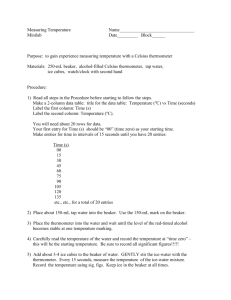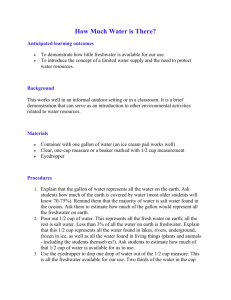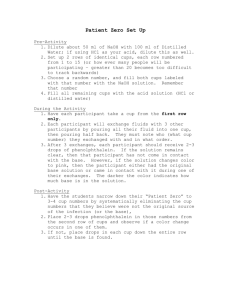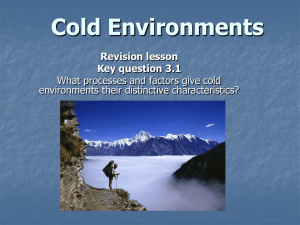Lab: Acid Rain and Weathering Rate
advertisement
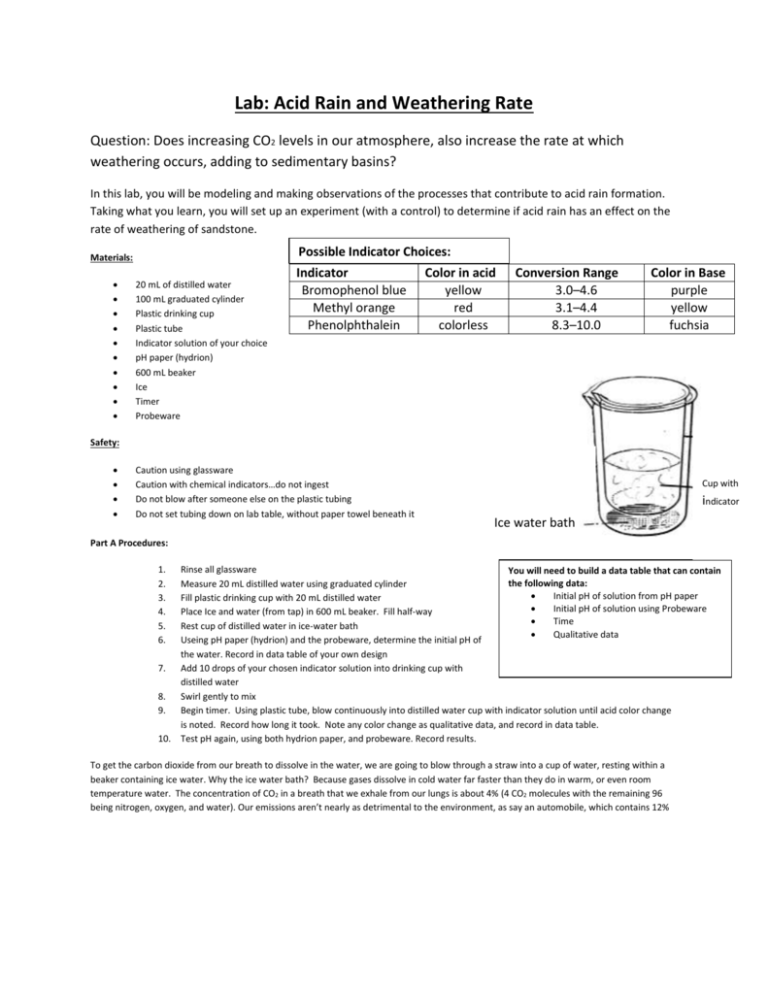
Lab: Acid Rain and Weathering Rate Question: Does increasing CO2 levels in our atmosphere, also increase the rate at which weathering occurs, adding to sedimentary basins? In this lab, you will be modeling and making observations of the processes that contribute to acid rain formation. Taking what you learn, you will set up an experiment (with a control) to determine if acid rain has an effect on the rate of weathering of sandstone. Possible Indicator Choices: Materials: 20 mL of distilled water 100 mL graduated cylinder Plastic drinking cup Plastic tube Indicator solution of your choice pH paper (hydrion) 600 mL beaker Ice Timer Probeware Indicator Bromophenol blue Methyl orange Phenolphthalein Color in acid yellow red colorless Conversion Range 3.0–4.6 3.1–4.4 8.3–10.0 Color in Base purple yellow fuchsia Safety: Caution using glassware Caution with chemical indicators…do not ingest Do not blow after someone else on the plastic tubing Do not set tubing down on lab table, without paper towel beneath it Cup with indicator Ice water bath Part A Procedures: 1. 2. 3. 4. 5. 6. Rinse all glassware You will need to build a data table that can contain the following data: Measure 20 mL distilled water using graduated cylinder Initial pH of solution from pH paper Fill plastic drinking cup with 20 mL distilled water Initial pH of solution using Probeware Place Ice and water (from tap) in 600 mL beaker. Fill half-way Time Rest cup of distilled water in ice-water bath Qualitative data Useing pH paper (hydrion) and the probeware, determine the initial pH of the water. Record in data table of your own design 7. Add 10 drops of your chosen indicator solution into drinking cup with distilled water 8. Swirl gently to mix 9. Begin timer. Using plastic tube, blow continuously into distilled water cup with indicator solution until acid color change is noted. Record how long it took. Note any color change as qualitative data, and record in data table. 10. Test pH again, using both hydrion paper, and probeware. Record results. To get the carbon dioxide from our breath to dissolve in the water, we are going to blow through a straw into a cup of water, resting within a beaker containing ice water. Why the ice water bath? Because gases dissolve in cold water far faster than they do in warm, or even room temperature water. The concentration of CO2 in a breath that we exhale from our lungs is about 4% (4 CO2 molecules with the remaining 96 being nitrogen, oxygen, and water). Our emissions aren’t nearly as detrimental to the environment, as say an automobile, which contains 12% After observing today’s activity, you are to design an experiment that will test if acid rain (carbonic acid) influences the rate of weathering. We will use any of the rock specimens you used in your mechanical weathering lab. Things to consider: What will be your control? Making a hypothesis Which sample? How acidic should you make it? Make the first three procedures Think safety! Design data tables Be ready to do it tomorrow! Go for it! Analysis Questions 1. 2. 3. 4. 5. 6. 7. 8. 9. Calculate the rate of weathering in each sample…the control, and the experiment. Graph your results. Which sample lost more mass? If you had been able to do this lab in multiple phases, over many days, how do you think the results would have differed? If you had exposed one of your samples to a base, instead of an acid (like ammonia), how do you think your results would have differed? What was the purpose of the water in your experiment? In your journal, don’t forget to indicate the following: a. Dependent variable b. Independent variable c. Control d. Constants Why do you think part A of this lab failed so miserably? If we had been able to create carbonic acid with our breath, and used that instead of the acid you choose, do you think your results would have been different?



